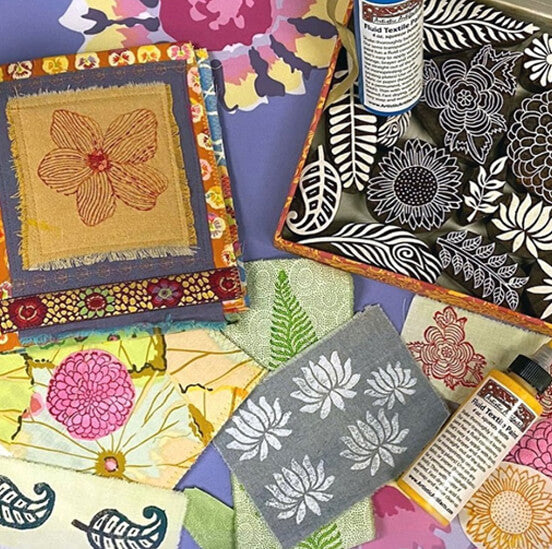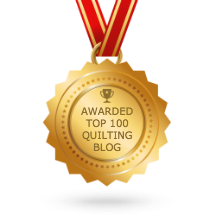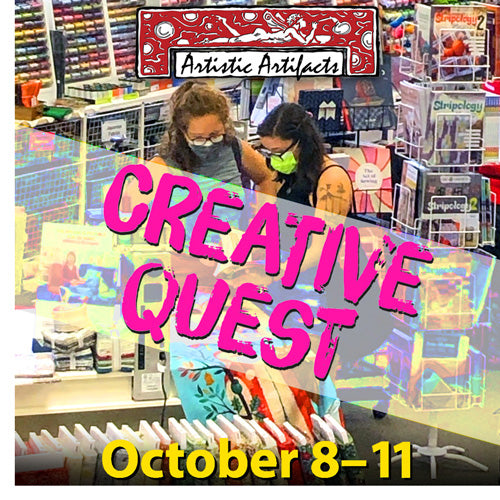Slow Stitched Outsider Art Quilt
Updated August 4, 2017: finished project photo, more

The Slow Stitching Movement has become very hot over the last couple of years. Mark Lipinski modeled it after the international Slow Food movement, open to all fiber and needle artists to prepare them for a higher form of creativity and important work in the needle and fiber arts.
I have to say that I have enjoyed renewing my acquaintance with hand stitching, inspired by my stitching gurus, Liz Kettle of Textile Evolution, and renowned stitch/fiber artist Ruth Chandler. They both were interviewed by Mark about the Slow Stitching movement — listen to their podcasts!

Another catalyst for my renewed interest was the publication of Ruth’s book Modern Hand Stitching, which gives you instructions for how to create basic stitches, and then shows the multiple ways you can use and alter it for a fresh new look. I comb the used book stores looking for for European hand stitching books — especially the Scandinavian ones. It’s official...I am hooked!
At one of our monthly JAMS meeting, a show & tell project by member Karen Scudder caused such a stir that she was asked to give the group a short demo at a future meeting. Karen had used a creative hand stitching and quilting technique commonly attributed to Teesha Moore (see the end of this post for more info and tutorial links). That demo has led to many little hand stitch quiltlets appearing at JAMS meetings, and a number of dedicated new fans of the process!

Not wanting to be left out of the fun, and wanting to use samples from wooden printing blocks demonstrations, I embarked on my own slow stitch project. Here is what I did:
Despite giving literally scores of them away, I still have a huge number of shirting fabric samples, so I used those as my backings, which also gave me a starting point as to the size of my blocks. I matched up the stamped fabric with backing of cotton shirting approximately the same size (for this technique, it’s often recommended that your backing fabric be a bit larger so it can be turned over to the front.

I used Nature-Fil™ Blend quilt batting (a blend of bamboo and rayon; stitches beautifully) and cut it slightly smaller than my front and back pieces of fabric. See the beginning of my quilt sandwich above.
Step 2 is to stitch around the block, by hand or machine (example right), to hold the pieces together. While it is possible to skip this step, I have found it does help stabilize it all for the subsequent steps.

The next step is to roll the edges and stitch around them, as shown above. Once you have a small quilt put together, it’s time to break out your floss and stitch away, using as many embroidery stitches as you desire. Many people embellish with beads or charms too, but that embellishing should take place after you have stitched the block completely (your stitches shrink the entire block somewhat; beads applied too early in the process could loosen or pucker).
Here are some samples of other blocks I have in process:

Ultimately I want to join the blocks together to create something. I don’t know what that something is yet, maybe a wall hanging? Journal cover? But this is what I have going so far.

This is a fun and portable project — as you can see in the bird block, I carry the needle with me everywhere!
Project Update: Completed!
Since beginning this in 2015, I continued to enjoy adding to my project, enlarging it and embellishing further. Plus, Artistic Artifacts has since became a WonderFil Specialty Threads “Threaducation” Center... so now I have even more yummy threads and fibers to use! Variegated threads like those from Sue Spargo's collection of Eleganza are beautiful:

Adding beading for another pop of color and texture:

My completed wall hanging, below. I encourage you to try this technique for yourself... it really is addicting! Scroll down for instructions by the originator of this method, Susan Shie, and a YouTube tutorial for a fabric journal by Teesha Moore, who popularized it.

More About These Techniques

Susan “Lucky” Shie (pronounced “shy”) is an amazing artist, and created a number of heavily stitched and embellished art quilts featured in Quilting Arts and elsewhere. For years she taught her methods; in 1999 she taught a class in her techniques that included Teesha Moore (see Susan’s online diary, scroll approximately halfway down the page). Susan writes that Teesha, “who had never made fabric art before, took to it really fast! She is primarily a stamp artist and journaler, who self publishes a wild stamp art quarterly. Her ability to translate her creativity over to fabric textures was wonderful!”
Although Susan ceased teaching this technique in 2006, she documented her methods in writing and continues to keep that tutorial online. Learn from the originator! Visit the Lucky School of Quilting Techniques »

With Susan’s permission, Teesha (and others) began teaching her own take on this stitching technique, using it to make art dolls, fabric journals and more. Teesha offers a free set of tutorial videos to create one of her fabric journals, constructed from units she calls pillows. (Teesha stuffs her fabric with polyfil stuffing, rather than using batting.) Watch for her own methods on constructing sewn and embellished fiber art:








Leave a comment